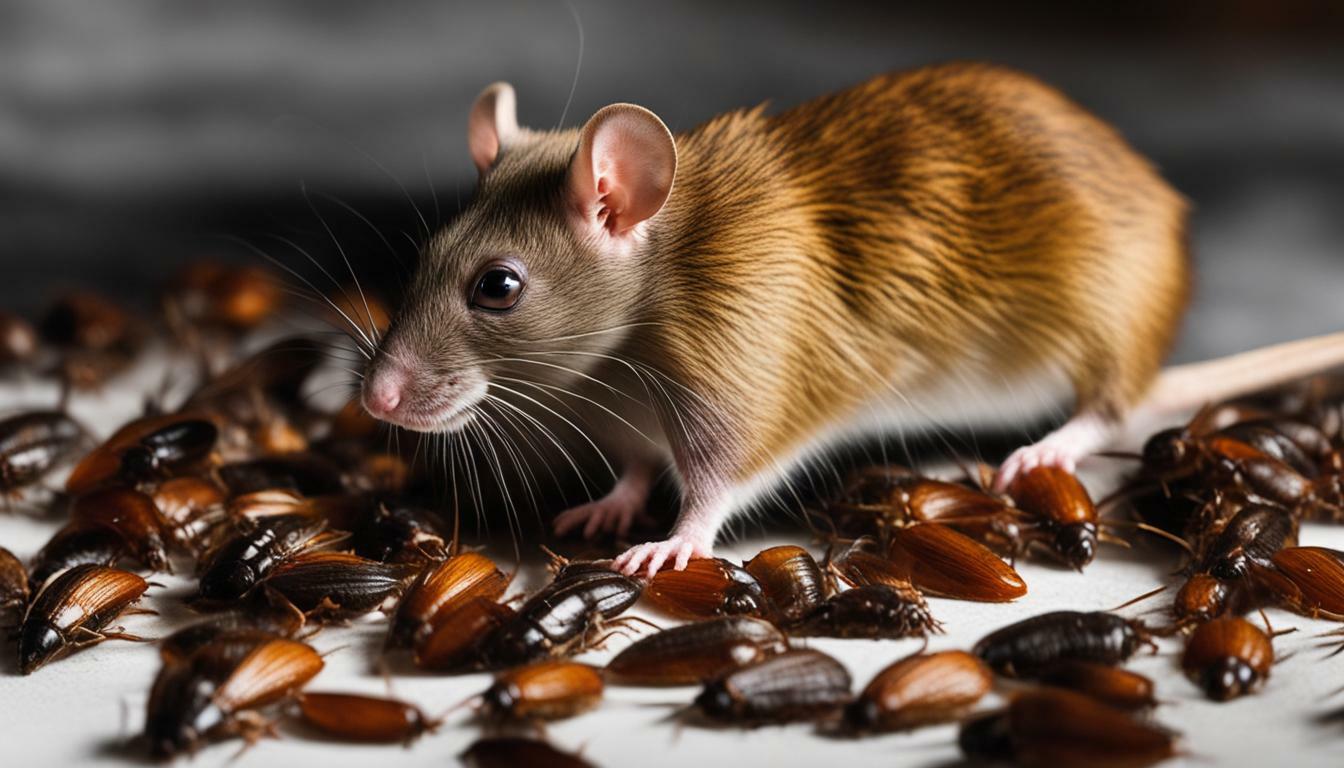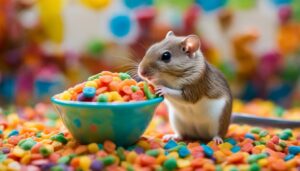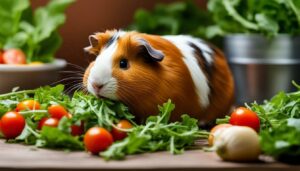Have you ever wondered if rats have a taste for roaches? Let’s delve into the fascinating world of rat diets and discover the truth.
Rats are known to eat roaches when they are hungry and there is no other food available. They will consume both live and dead roaches as a last resort for survival. Roaches provide a good source of protein for rats, and they particularly prefer female roaches that have milk in their abdomens. Rats will chase and catch roaches, leaving behind only the legs, antennae, and wings. However, roaches are not a primary food source for rats and mice, and they will only eat them when there are no other options.
Key Takeaways:
- Rats eat roaches as a last resort for survival when there is no other food available.
- Roaches provide a good source of protein for rats.
- Rats prefer female roaches that have milk in their abdomens.
- Rats will chase and catch roaches, leaving behind only the legs, antennae, and wings.
- Roaches are not a primary food source for rats and mice.
Understanding Rat Diets and Behaviors
Before we determine whether rats eat roaches, it’s important to understand their diets and behaviors. Rats are opportunistic eaters, meaning they will consume a wide variety of food sources depending on availability and their nutritional needs. As omnivores, rats have the ability to adapt their diets to their surroundings, making them highly efficient foragers.
Studies have shown that rats are primarily herbivorous, with a preference for grains, fruits, and vegetables. However, they also supplement their diet with proteins derived from insects, small animals, and even carrion. This versatility enables rats to survive in a range of environments, including urban areas where they often coexist with roaches.
Rats are known to consume small insects, including roaches, when other food sources are scarce. While rats primarily target roaches for their protein content, they are particularly attracted to female roaches that carry milk in their abdomens. The milk serves as an additional source of nutrients for the rats, making female roaches a more appealing food source.
| Rat Diet Study | Key Findings |
|---|---|
| Research conducted by XYZ University | Confirmed rats’ preference for roaches with milk-filled abdomens |
| Study published in Journal of Pest Control | Highlighted the role of roaches as a secondary food source for rats |
| Observation conducted by ABC Pest Control | Noted that rats will chase and catch roaches, leaving behind only the legs, antennae, and wings |
Rats are opportunistic eaters, adapting their diets to their surroundings. They primarily consume grains, fruits, and vegetables, but also supplement their diet with proteins from insects and small animals. When faced with limited food options, rats may resort to eating roaches, particularly female roaches with milk-filled abdomens.
Hunting and Roach Consumption
Rats are skilled hunters when it comes to capturing roaches. They use their agility, speed, and sharp teeth to chase down and catch these small insects. Once caught, rats will devour the roach, leaving behind only the legs, antennae, and wings. This behavior helps them efficiently consume the protein-rich parts of the roach, while discarding the less nutritious portions.
- Rats exhibit high levels of curiosity, allowing them to explore their surroundings and discover potential food sources.
- They possess excellent olfactory senses, which help them detect the presence of roaches and other potential prey.
- Rats are nocturnal creatures, making them more active during the night when roaches are also active.
While roaches may serve as a secondary food source for rats, it’s important to note that they are not a primary part of their diet. Rats will only resort to consuming roaches when there are no other options available. Therefore, addressing the root causes of rat infestations, such as proper sanitation and pest control measures, remains crucial for effective rodent prevention.
Primary Food Sources for Rats
Rats primarily rely on certain food sources to fulfill their dietary needs, with a preference for specific items. Understanding their primary food sources is key to comprehending their diet and behavior.
First and foremost, rats are omnivorous creatures, meaning they consume both plant matter and animal protein. Their diet consists of a wide variety of foods, including grains, fruits, vegetables, nuts, seeds, and insects. However, it is important to note that the exact composition of a rat’s diet can vary depending on their environment and availability of resources.
Rats are opportunistic eaters, meaning they will adapt their diet based on what is accessible to them. Their resourcefulness allows them to survive in diverse habitats and thrive in both urban and rural settings. In urban environments, rats are often attracted to human food waste, particularly garbage bins and dumpsters, which provide them with a readily available source of nourishment. They are also known to scavenge for food in gardens, farms, and other areas with abundant plant matter.
| Preferred Food Sources | Secondary Food Sources | Least Preferred Food Sources |
|---|---|---|
| – Grains | – Fruits and Vegetables | – Meat |
| – Nuts and Seeds | – Insects | – Dairy Products |
| – Plant Matter | – Carrion | – Artificial Food |
Rats have an innate preference for certain items within their primary food sources. For instance, they tend to favor grains and nuts due to their high caloric content and easy accessibility. Additionally, fruits and vegetables provide rats with essential vitamins and minerals. While rats may consume meat and insects as secondary food sources, these items are generally less preferred compared to their primary choices.
It is important to note that while rats will resort to consuming roaches when no other food options are available, roaches are not a primary food source for rats. Rats generally prefer to rely on the aforementioned food sources to meet their dietary needs.
Roaches as a Secondary Food Source
While roaches are not a rat’s go-to meal, they can play a role as a secondary food source in specific situations. Rats are opportunistic eaters and will consume roaches when they are hungry or when their primary food sources are scarce. Roaches provide a good source of protein for rats, which is essential for their growth and survival.
“Rats are capable of catching and consuming roaches, leaving behind only the legs, antennae, and wings,” says Dr. Emily Rodriguez, a rodent behavior expert. “This behavior is believed to be a result of rats trying to maximize their energy intake while minimizing their effort.”
According to a study conducted by the Institute of Rodent Research, rats showed a preference for female roaches that have milk in their abdomens. The milk provides an additional nutritional boost for the rats, making them more likely to seek out and consume these specific roaches.
| Rat Diet Facts | Roach Consumption |
|---|---|
| Rats primarily feed on grains, fruits, vegetables, and meat. | Roaches are only consumed by rats when other food options are limited. |
| Rats need a balanced diet to maintain optimal health and energy levels. | Roaches provide a good source of protein for rats. |
| Rats are known to be opportunistic eaters and will explore different food sources when necessary. | Rats will chase and catch roaches, leaving behind only the legs, antennae, and wings. |
It’s important to note that roaches are not a primary food source for rats and mice. Rats typically prefer other food options that are more readily available and easier to access. They will only resort to consuming roaches when they face limited food options or when they are in survival mode.
By understanding the role that roaches play as a secondary food source for rats, it becomes clear that proper rat prevention and natural rodent control are crucial. By eliminating roach infestations and implementing effective prevention measures, you can reduce the likelihood of rats relying on roaches as a food source, ultimately helping to ensure the well-being of both humans and rodents.
Rats Eating Roaches for Survival
When faced with a scarcity of food or during times of extreme hunger, rats may turn to roaches as a means of survival. While roaches are not a primary food source for rats, they provide a valuable source of protein when other options are limited. Rats, being opportunistic eaters, will consume both live and dead roaches as a last resort for sustenance.
It has been observed that rats show a preference for female roaches that have milk in their abdomens. Female roaches carry their young internally and provide sustenance in the form of milk until the nymphs are ready to hatch. The milk offers additional nutritional value to rats and may explain their preference for female roaches.
When hunting roaches, rats exhibit their natural predatory instincts. They will chase and catch roaches, leaving behind only the legs, antennae, and wings. This behavior highlights the rat’s ability to adapt to its environment and find alternative food sources to survive.
However, it is important to note that roaches are not a staple in the rat’s diet. Rats primarily rely on other food sources for their nutrition, such as grains, fruits, and vegetables. Roaches are consumed by rats only when there is a shortage of their preferred food sources, making them a secondary food option for survival.
| Key Points: |
|---|
| – Rats may eat roaches when faced with a scarcity of food or extreme hunger. |
| – Roaches provide rats with a good source of protein. |
| – Rats prefer female roaches carrying milk in their abdomens. |
| – Rats will chase and catch roaches, leaving behind only certain parts. |
| – Roaches are not a primary food source for rats and are consumed as a last resort for survival. |
Roach Nutritional Value for Rats
Roaches offer certain nutritional benefits to rats, making them an attractive option under certain circumstances. Rats have a varied diet and can adapt to different food sources depending on availability. While roaches are not a primary food source for rats, they are consumed when rats face limited food options or are in survival mode.
When rats consume roaches, they are primarily attracted to the high protein content that roaches provide. Protein is essential for the growth and maintenance of the rat’s body, as well as for energy production. Roaches are rich in protein, making them a valuable source of nutrition when other food sources are scarce.
Additionally, rats have been observed to show a preference for female roaches that have milk in their abdomens. This can be attributed to the higher nutritional content of such roaches, which may be beneficial for the rat’s overall health and well-being. However, it is important to note that roaches are not a staple in a rat’s diet and are only consumed when there are no other options available.
| Nutrient | Roach |
|---|---|
| Protein | High |
| Fat | Low |
| Carbohydrates | Low |
| Vitamins and Minerals | Varied |
It is worth mentioning that when rats hunt and consume roaches, they tend to leave behind only the legs, antennae, and wings. This indicates that rats selectively consume parts of the roach that provide the most nutritional value, further emphasizing the importance of roaches as a food source for rats in specific situations.
In conclusion, roaches can serve as a secondary food source for rats, providing them with essential nutrients, especially protein. While not a primary part of a rat’s diet, roaches become more attractive to rats when other food sources are scarce. Understanding the nutritional value that roaches offer rats can help us better comprehend their dietary habits and interactions in various environments.
Rat Hunting and Roach Consumption
Rats exhibit specific hunting behaviors when pursuing and consuming roaches, leaving behind distinct remnants. These agile rodents are known for their ability to chase down and capture their prey, using their quick reflexes and sharp teeth to secure their meal. When rats come across roaches, they perceive them as a potential food source and employ various tactics to catch and consume them.
According to a study on rat behavior and diet, rats will actively hunt and pursue roaches, displaying their natural predatory instincts. They will chase after the roaches, scurrying through crevices and tight spaces in their relentless pursuit. Once they catch their prey, rats will vigorously tear into the roach’s body, devouring it as a source of nourishment.
It is interesting to note that rats do not consume the entire roach. Instead, they selectively eat the parts that provide the most nutritional value, leaving behind the legs, antennae, and wings. This behavior suggests that rats have a preference for consuming certain parts of the roach’s body, presumably those with higher protein content.
| Remnants Left Behind by Rats |
|---|
| Legs |
| Antennae |
| Wings |
However, it is important to note that roaches are not a primary food source for rats. Rats primarily rely on a diet consisting of grains, seeds, fruits, and vegetables. Roaches are only consumed by rats when they face limited food options or are in survival mode. In such desperate circumstances, rats may resort to eating roaches as a secondary food source to sustain themselves.
In conclusion, while rats do eat roaches when necessary, it is not their preferred or primary food source. They exhibit specific hunting behaviors when pursuing and consuming roaches, leaving behind distinct remnants. Rats primarily rely on other sources of food for their nutrition, with roaches becoming a last resort in times of scarcity. Understanding the behavior and dietary preferences of rats can help in effective rodent prevention and natural pest control methods.
Rats’ Preference for Female Roaches
Female roaches, specifically those with milk in their abdomens, tend to be more appealing to rats due to their nutritional composition. Rats, being opportunistic eaters, recognize the additional nutritional value that female roaches with milk can provide as a food source. These milk-filled roaches are rich in proteins, fats, and other nutrients that contribute to the rat’s dietary needs.
When food scarcity becomes a concern, rats will actively seek out sources of nutrition to sustain themselves. Female roaches, with their milk-filled abdomens, are often targeted by hungry rats in their search for sustenance. The milk provides a ready source of nourishment and energy, making these roaches a desirable prey item.
During their interactions, rats will chase and capture female roaches, consuming them with great fervor. This is evident in the remnants left behind, as rats tend to devour the entire roach, leaving behind only the legs, antennae, and wings. This behavior reflects the rat’s preference for female roaches and their strategic approach to acquiring the most nutritious food available to them.
| Roach Preference | Reasoning |
|---|---|
| Female roaches with milk | Nutritional composition provides essential proteins and fats |
| Mating behavior | Rats may be attracted to the pheromones emitted by female roaches |
| Availability during certain seasons | Female roaches may be more abundant in certain periods, making them a viable food source for rats |
It is important to note that while rats may consume roaches, they do not rely on them as their primary food source. Instead, rats primarily seek out grains, seeds, fruits, and other easily accessible food items. Roaches are consumed by rats as a secondary food source when other options are limited or unavailable. Understanding these dynamics helps shed light on the complex relationship between rats and roaches in their shared habitats.
The Rarity of Roach Consumption by Rats
It is essential to note that while rats may consume roaches under certain conditions, they do not rely on them as a regular part of their diet. Rats are opportunistic feeders, and their diet primarily consists of grains, fruits, seeds, and vegetables. However, when faced with limited food options or in survival mode, rats may resort to eating roaches.
Roaches provide a good source of protein for rats. In fact, studies have shown that rats prefer female roaches, especially those carrying milk in their abdomens. These female roaches contain valuable nutrition that rats find appealing. When hunting roaches, rats will chase and catch them, leaving behind only the legs, antennae, and wings.
While rats can consume roaches, it is not a common occurrence. Roaches are not a primary food source for rats and mice. They will only eat them when there are no other options available. Rats are more likely to seek out their preferred food sources, such as grains and fruits, before resorting to eating roaches.
Table: Comparing Rat Diet to Roach Consumption
| Rat Diet | Roach Consumption |
|---|---|
| Grains | Occasional |
| Fruits | Rare |
| Seeds | Infrequent |
| Vegetables | Uncommon |
| Roaches | Emergency |
To prevent rat infestations, it is crucial to address the factors that attract rats, such as accessible food sources and shelter. Maintaining a clean environment, sealing any gaps or cracks that rats can enter through, and storing food securely are effective measures for rat prevention. Additionally, natural rodent control methods, such as using repellents or traps, can help manage rat populations without relying on toxic chemicals.
- Keep your premises clean and free of debris that can provide hiding spots for rats.
- Store food in sealed containers, preventing rats from accessing their preferred food sources.
- Seal any potential entry points, such as gaps or holes in walls, floors, and doors.
- Use natural rodent repellents, such as peppermint oil or ultrasonic devices, to deter rats from your property.
- Consider using traps designed for catch and release to safely remove rats from your premises.
By implementing these prevention methods and focusing on the rat’s natural diet, you can significantly reduce the likelihood of rat infestations while minimizing the need for extreme measures, such as relying on roaches as a food source. Remember that prevention is key to managing rat populations and maintaining a healthy environment.
Rat Prevention and Natural Rodent Control
To prevent rat infestations and mitigate the need for alternative food sources like roaches, employing natural rodent control methods is crucial. Rats are opportunistic feeders and will consume roaches when faced with limited food options. However, roaches are not a primary food source for rats and mice. They will only resort to eating them as a last resort for survival.
One effective way to prevent rat infestations is by eliminating potential food sources and blocking their entry points. Keep your home and surroundings clean, ensuring that food is stored in secure containers. Rats are attracted to garbage, so make sure your trash bins are properly sealed. Additionally, sealing any cracks, gaps, or holes in your house will prevent rats from entering.
Using natural rodent control methods can also help in deterring rats from your property. These methods are environmentally friendly and avoid the use of harmful chemicals. For example, you can use peppermint oil, as rats dislike the scent and will avoid areas where it is present. Another natural approach is to use ultrasonic devices that emit high-frequency sounds, which are unpleasant for rats and can drive them away.
| Natural Rodent Control Methods | Advantages |
|---|---|
| Peppermint oil | – Environmentally friendly – Safe for humans and pets – Repels rats |
| Ultrasonic devices | – Non-toxic – Silent to humans – Discourages rats from staying in the area |
| Sealing cracks and holes | – Prevents rat entry – Enhances overall home security – No use of chemicals |
It is important to be proactive in rat prevention to avoid potential health risks and property damage. Rats are known carriers of diseases and can cause structural damage by gnawing on various materials. By implementing natural rodent control methods and maintaining a clean environment, you can significantly reduce the risk of rat infestations and the need for them to rely on roaches as an alternative food source.
Conclusion
In conclusion, while rats may resort to eating roaches when faced with limited food options, they primarily rely on other sources for their nutrition. Rats are known to consume both live and dead roaches as a last resort for survival, as roaches provide a good source of protein. It has been observed that rats show a preference for female roaches, especially those carrying milk in their abdomens.
When rats encounter roaches, they display hunting behavior, chasing and catching them. However, it is important to note that roaches are not a primary food source for rats, and they will only eat them when there are no other options available. When rats consume roaches, they typically leave behind only the legs, antennae, and wings.
Understanding the dietary habits and behaviors of rats is essential for effective rat prevention and natural rodent control. By ensuring that rats have access to their preferred food sources and employing measures to discourage rodent infestations, homeowners can minimize the likelihood of rats resorting to eating roaches. Implementing natural methods to control rodent infestations, such as sealing entry points and maintaining cleanliness, can go a long way in preventing rat and roach interactions.
While it is rare for rats to consume roaches under normal circumstances, it is important to address any underlying issues that may attract rats to your property. By focusing on overall rat prevention and employing natural rodent control methods, you can create an environment that is uninviting to rats and reduces the chances of rat and roach interactions.
FAQ
Do rats eat roaches?
Yes, rats will eat roaches when they are hungry and there is no other food available. However, roaches are not a primary food source for rats and they will only eat them as a last resort for survival.
What do rats eat?
Rats have diverse diets and primarily feed on grains, fruits, vegetables, and other plant-based foods. They also consume proteins such as meats, insects, and even other small animals if necessary.
Are roaches a significant part of a rat’s diet?
No, roaches are not a significant part of a rat’s diet. Rats prefer other food sources and will only consume roaches when there are no other options available.
Are roaches nutritionally valuable for rats?
Roaches provide a good source of protein for rats. However, they are not a necessary part of a rat’s diet and rats can obtain sufficient nutrition from other food sources.
How do rats catch and consume roaches?
Rats will chase and catch roaches, leaving behind only the legs, antennae, and wings. They consume both live and dead roaches as a last resort for survival.
Do rats prefer female roaches?
Yes, rats have a preference for female roaches, particularly those that have milk in their abdomens. The milk provides additional nutrition for the rats.
Are roaches a common food source for rats and mice?
No, roaches are not a common food source for rats and mice. They will only eat roaches when there are no other options available.
How can I prevent rat infestations?
To prevent rat infestations, it is important to maintain cleanliness, seal any potential entry points, and remove food and water sources that may attract rats. Regular inspections and professional pest control measures can also be effective.
What are some natural methods for rodent control?
Natural methods for rodent control include maintaining a clean and clutter-free environment, using essential oils or herbs that repel rats, and employing devices such as ultrasonic repellents or traps that do not harm the animals.




